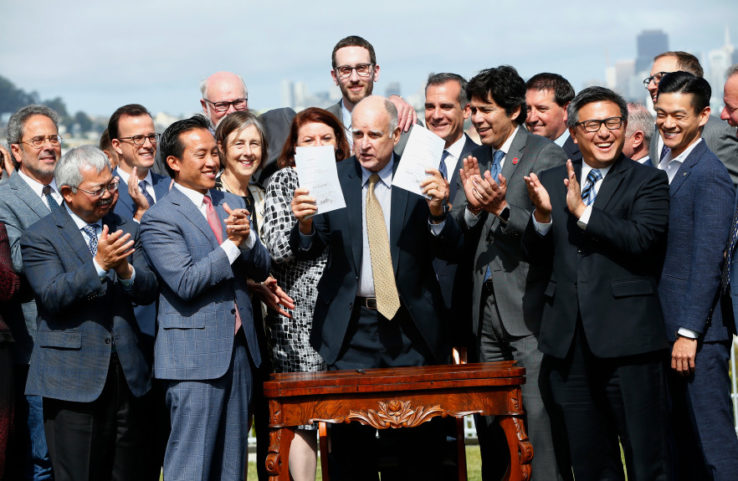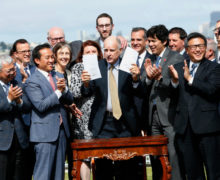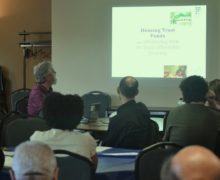Governor of California Signs Historic Housing Package, Dedicated Revenue for Housing Trust Fund

At what he called “probably the biggest bill signing” he’s ever seen, Governor Jerry Brown signed 15 bills into law on September 29 to address the needs of Californians most impacted by California’s housing catastrophe. The historic signing event in San Francisco brought together champion legislators and allies. Housing California Executive Director Lisa Hershey represented the affordable housing community, the Residents United Network, and advocacy partners.
“We are all ready for progress,” Hershey said. “We look forward to building on our momentum with state leaders, community champions, and most importantly, our residents, who made the real difference in getting this legislature to hear them and take action on the top issue facing Californians today.”
Hershey was referring to the integral role played by the Residents United Network (RUN), the organizing arm of Housing California in partnership with the Center for Community Change, in changing the minds and getting the votes of key legislators.
Over the course of the legislative session, which starts at the beginning of the year and goes through October 15 — the last day the Governor can sign bills — RUN joined affordable housing developers and advocates in statewide in-district visits, testified in and marched the halls of the State Capitol several times, held two Lobby Days in Sacramento, and provided media interviews and letters to the editor to successfully help move a package of affordable housing bills that the Governor signed.
Housing California and RUN found that bringing a diverse group comprised of developers, service providers, advocates and residents together to meetings with legislators and Capitol hearings had the greatest impact.
Affordable housing developers and regional advocates in specific districts also played a key role, bringing stories and data of their new and future developments to legislators and showing why new investment and reform is needed.
RUN-supported bills included Senate Bill 2, local investment in affordable homes; and Senate Bill 3, an affordable housing bond that will be on the 2018 state ballot. RUN plans to campaign heavily for the next year to ensure the bond passes.
- Senate Bill 2 (Atkins), the Building Homes and Jobs Act, establishes a new $75 recording fee on real estate transactions (excluding new home purchases) to an ongoing source of funding for affordable housing. The fee is projected to generate roughly $200 million to $300 million per year. Over the long-term most funds — to be held in a new Building Homes and Jobs Fund at the State Treasury — will be distributed to local governments to fund affordable housing development, while the first year of funding will primarily support homelessness services and capacity building in local government to improve housing planning.
- Senate Bill 3 (Beall), the Affordable Housing Bond Act of 2018, places a measure on the November 2018 statewide ballot to raise $4 billion in bonds, with $3 billion going to fund affordable housing development through existing state programs (including $300 million for the Local Housing Trust Fund Matching Grant Program) and $1 billion to support affordable homeownership opportunities for veterans (with these funds paid back to the state through veterans’ mortgage payments).
Another key bill in the package sponsored by Housing California and long fought for by housing advocates was Assembly Bill 1505.
- Assembly Bill 1505 (Bloom) was written to overrule a 2009 appellate court decision (Palmer/Sixth Street Properties LP vs City of Los Angeles) that stipulated that inclusionary zoning policies could not be applied to rental housing developments. Many California jurisdictions have inclusionary zoning policies in place for ownership housing, and many applied these policies to rental housing prior to 2009, so the “Palmer Fix” restores this local planning mechanism as a tool to regulate the production of rental housing.
Affordable and supportive housing developers in California will now have the opportunity to create and preserve homes statewide using funds from SB 2. Voters and organizers must start the campaign now to pass a $4 billion housing bond (SB 3) in 2018. California residents must all contact our local governments and work together to reinstate or create inclusionary zoning ordinances (AB 1505). Housing California and RUN will also continue to monitor localities to ensure proper implementation of changes to housing element law (SB 166, AB 72, AB 1397, and more). Here are the basics on all the bills in the package.
On October 14, Governor Brown also signed RUN’s third priority bill, which was co-sponsored by Housing California and the Corporation for Supportive Housing: AB 74. This bill establishes the Housing for a Healthy California Program, to provide much-needed housing assistance to Californians experiencing homelessness.
AB 74 offers a whole person-oriented approach to serving the most vulnerable Californians. The Program ties housing resources available through the National Housing Trust Fund, a dedicated source of federal funding the state receives every year, to services through Medi-Cal to create supportive housing for the most expensive Medi-Cal beneficiaries who are incurring disproportionate health care expenditures because they are homeless.
Californians experiencing long-term homelessness face a combination of chronic medical, mental health, and substance abuse conditions. Their inability to access preventive and regular care harms their health and often shaves years off their lives. Study after study show supportive housing decreases emergency department visits, hospital inpatient stays, nursing home stays, and psychiatric inpatient admissions, saving $3,841 to over $24,000 per beneficiary, above the costs of housing and services.
Housing Trust Fund money will be used to build housing and provide rental assistance while services will be paid for through the Whole Person Care pilot program, Health Homes, or some other county-controlled funding source. The program also allows the state to track health outcomes, healthcare utilization, and Medi-Cal cost changes from moving vulnerable residents from homelessness to housing stability.
“California is home to twenty percent of the nation’s homeless population and one-third of the nation’s chronically homeless population. I’m gratified that Governor Brown is helping to advance significant and innovative solutions to address this crisis,” said Assemblymember Chiu, Chair of the Assembly Housing and Community Development Committee. “This new program shifts the paradigm for how we tackle homelessness among people who have been without a roof for far too long.”
For more information on Housing California and the Residents United Network, visit housingca.org.
To read more about the Center for Community Change’s resident organizing initiatives, go to: Resident Organizing Gains Victory in California, Attention from Other States





